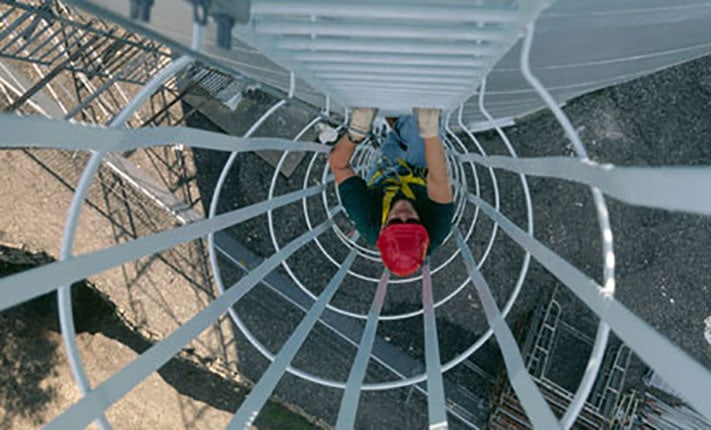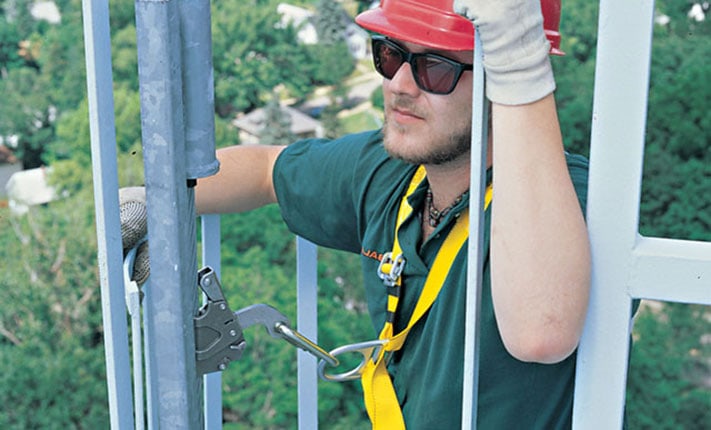Fall Protection & Fall Arrest Systems for the Water Tower Industry
While water towers are important to many municipal water systems, they also present significant fall hazards. Municipal water tower maintenance activities such as inspection, sandblasting, and painting require a comprehensive fall prevention strategy, which includes the proper mix of water tower fall protection equipment, a descent and rescue plan, personnel training, and partnering with a fall protection company that appreciates the unique nature of your access points and potential fall hazards.

Water Tower Fall Protection

Water Tower Fall Protection
We are a complete turnkey provider of fall protection systems designed for the municipal water industry and have the years of design and installation experience in this market sector. Contact us for expert assistance with your fall arrest, fall restraint and fall protection requirements.
System Types
-
Fall Protection Anchors
Fall Protection Anchors -
Guardrail
View Guardrail -
Rescue and Descent Systems
View Rescue and Descent Systems -
Vertical Lifelines and Ladder Systems
View Vertical Lifelines and Ladder Systems
Design Considerations
Water Tower Fall Protection Design Considerations Because the primary maintenance areas are elevated above ground level, ladder systems are common water fixtures on most water towers. Ladder systems can be internally housed, but more typically, the service platforms on water towers are accessed using external ladder systems that are exposed to the corrosive effects of the elements. In addition to water, internal ladder systems are subjected to chlorine exposure. The tank area is accessed using a perimeter catwalk, while the top of the dome itself is reached using a curved or radial style ladder. In addition to OSHA regulations, most water tower installations are also subject to local safety codes which vary by municipality. Ladders equipped with vertical lifeline systems protect maintenance personnel from fall hazards as they make their way from the ground level to the perimeter catwalk surrounding the tank. Special care must be taken to protect workers as they transition from the ladder to the work platform, which in most cases, utilizes a guardrail system. In addition, a cable tie off system that takes into account the curvature of the tank must be installed to provide safe access. The corrosive effects of water, chlorine, and airborne elements makes stainless steel an ideal material selection for water tower fall protection systems. Our vast knowledge of local code provisions, personnel training, and experience installing OSHA compliant water tower fall protection systems will keep your facility, and more importantly, your maintenance staff safe.
OSHA Regulations
- HLL/VLL
- 1926.502(d) 'Personal fall arrest systems.' Personal fall arrest systems and their use shall comply with the provisions set forth below. Effective January 1, 1998, body belts are not acceptable as part of a personal fall arrest system. Note: The use of a body belt in a positioning device system is acceptable and is regulated under paragraph (e) of this section.
- 1926.502(d)(8) Horizontal lifelines shall be designed, installed, and used, under the supervision of a qualified person, as part of a complete personal fall arrest system, which maintains a safety factor of at least two.
- 1926.502(d)(9) Lanyards and vertical lifelines shall have a minimum breaking strength of 5,000 pounds (22.2 kN).
- 1926.502(d)(10) 1926.502(d)(10)(i) Except as provided in paragraph (d)(10)(ii) of this section, when vertical lifelines are used, each employee shall be attached to a separate lifeline.
- 1926.502(d)(11) Lifelines shall be protected against being cut or abraded.
- 1926.502(d)(12) Self-retracting lifelines and lanyards which automatically limit free fall distance to 2 feet (0.61 m) or less shall be capable of sustaining a minimum tensile load of 3,000 pounds (13.3 kN) applied to the device with the lifeline or lanyard in the fully extended position.
- 1926.502(d)(13) Self-retracting lifelines and lanyards which do not limit free fall distance to 2 feet (0.61 m) or less, ripstitch lanyards, and tearing and deforming lanyards shall be capable of sustaining a minimum tensile load of 5,000 pounds (22.2 kN) applied to the device with the lifeline or lanyard in the fully extended position.
- Personal Fall Arrest Systems
- 1926.502(d) 'Personal fall arrest systems.' Personal fall arrest systems and their use shall comply with the provisions set forth below. Effective January 1, 1998, body belts are not acceptable as part of a personal fall arrest system. Note: The use of a body belt in a positioning device system is acceptable and is regulated under paragraph (e) of this section.
- 1926.502(d)(16) Personal fall arrest systems, when stopping a fall, shall:
- 1926.502(d)(16)(i) limit maximum arresting force on an employee to 900 pounds (4 kN) when used with a body belt;
- 1926.502(d)(16)(ii) limit maximum arresting force on an employee to 1,800 pounds (8 kN) when used with a body harness;
- 1926.502(d)(16)(iii) be rigged such that an employee can neither free fall more than 6 feet (1.8 m), nor contact any lower level;
- 1926.502(d)(16)(iv) bring an employee to a complete stop and limit maximum deceleration distance an employee travels to 3.5 feet (1.07 m); and,
- 1926.502(d)(16)(v) have sufficient strength to withstand twice the potential impact energy of an employee free falling a distance of 6 feet (1.8 m), or the free fall distance permitted by the system, whichever is less.
- Ladders
-
- 1910.23(d) Fixed ladders. The employer must ensure:
- 1910.23(d)(1) Fixed ladders are capable of supporting their maximum intended load;
- 1910.23(d)(2) The minimum perpendicular distance from the centerline of the steps or rungs, or grab bars, or both, to the nearest permanent object in back of the ladder is 7 inches (18 cm), except for elevator pit ladders, which have a minimum perpendicular distance of 4.5 inches (11 cm);
- 1910.23(d)(3) Grab bars do not protrude on the climbing side beyond the rungs of the ladder that they serve;
- 1910.23(d)(4) The side rails of through or sidestep ladders extend at least 42 inches (1.1 m) above the top of the access level or landing platform served by the ladder. For parapet ladders, the access level is:
- 1910.23(d)(4)(i) The roof, if the parapet is cut to permit passage through the parapet; or
- 1910.23(d)(4)(ii) The top of the parapet, if the parapet is continuous;
- 1910.23(d)(5) For through ladders, the steps or rungs are omitted from the extensions, and the side rails are flared to provide not less than 24 inches (61cm) and not more than 30 inches (76 cm) of clearance. When a ladder safety system is provided, the maximum clearance between side rails of the extension must not exceed 36 inches (91 cm);
- 1910.23(d)(6) For side-step ladders, the side rails, rungs, and steps must be continuous in the extension (see Figure D-2 of this section);
- 1910.23(d)(7) Grab bars extend 42 inches (1.1 m) above the access level or landing platforms served by the ladder;
- 1910.23(d)(8) The minimum size (cross-section) of grab bars is the same size as the rungs of the ladder.
- 1910.23(d)(9) When a fixed ladder terminates at a hatch (see Figure D-3 of this section), the hatch cover:
- 1910.23(d)(9)(i) Opens with sufficient clearance to provide easy access to or from the ladder; and
- 1910.23(d)(9)(ii) Opens at least 70 degrees from horizontal if the hatch is counterbalanced;
- 1910.23(d)(10) Individual-rung ladders are constructed to prevent the employee's feet from sliding off the ends of the rungs (see Figure D-4 of this section);
- 1910.23(d)(11) Fixed ladders having a pitch greater than 90 degrees from the horizontal are not used;
- 1910.23(d)(12) The step-across distance from the centerline of the rungs or steps is:
- 1910.23(d)(12)(i) For through ladders, not less than 7 inches (18 cm) and not more than 12 inches (30 cm) to the nearest edge of the structure, building, or equipment accessed from the ladders;
- 1910.23(d)(12)(ii) For side-step ladders, not less than 15 inches (38 cm) and not more than 20 inches (51 cm) to the access points of the platform edge;
- 1910.23(d)(13) Fixed ladders that do not have cages or wells have:
- 1910.23(d)(13)(i) A clear width of at least 15 inches (38 cm) on each side of the ladder centerline to the nearest permanent object; and
- 1910.23(d)(13)(ii) A minimum perpendicular distance of 30 inches (76 cm) from the centerline of the steps or rungs to the nearest object on the climbing side. When unavoidable obstructions are encountered, the minimum clearance at the obstruction may be reduced to 24 inches (61 cm), provided deflector plates are installed
- 1910.28(b)(9) Fixed ladders (that extend more than 24 feet (7.3 m) above a lower level).
- 1910.28(b)(9)(i) For fixed ladders that extend more than 24 feet (7.3 m) above a lower level, the employer must ensure:
- 1910.28(b)(9)(i)(A) Existing fixed ladders. Each fixed ladder installed before November 19th 2018, is equipped with a personal fall arrest system, ladder safety system, cage, or well;
- 1910.28(b)(9)(i)(B) New fixed ladders. Each fixed ladder installed on and after November 19, 2018, is equipped with a personal fall arrest system or a ladder safety system;
- 1910.28(b)(9)(i)(C) Replacement. When a fixed ladder, cage, or well, or any portion of a section thereof, is replaced, a personal fall arrest system or ladder safety system is installed in at least that section of the fixed ladder, cage, or well where the replacement is located; and
- 1910.28(b)(9)(i)(D) Final deadline. On and after November 18, 2036, all fixed ladders are equipped with a personal fall arrest system or a ladder safety system.
Talk to a fall protection specialist
Tell us about your fall protection needs, and we’ll configure a system that rises to your challenges.

